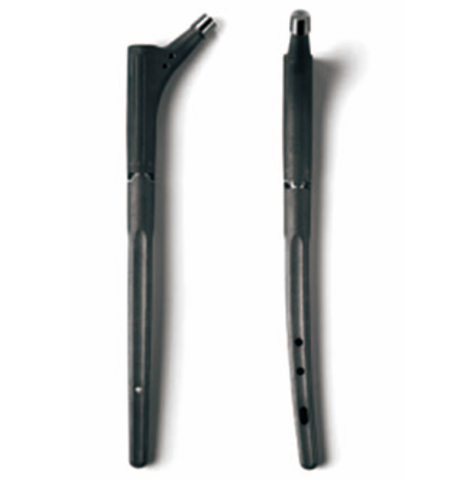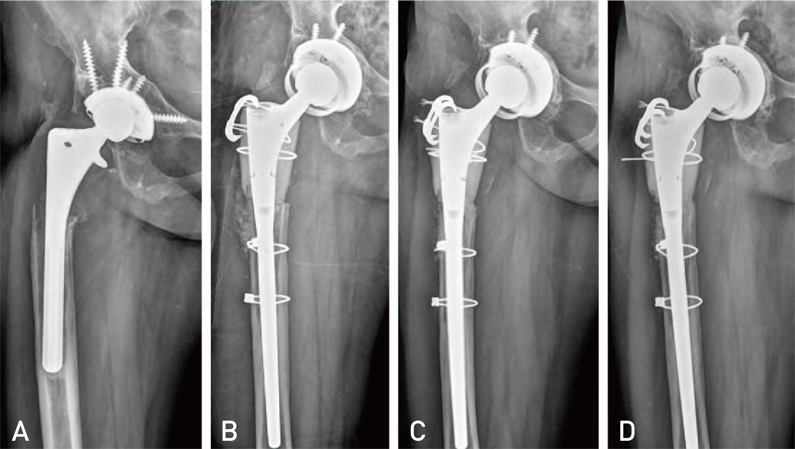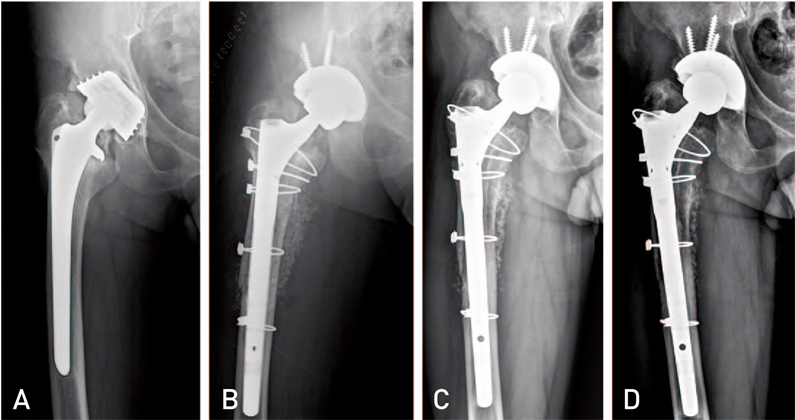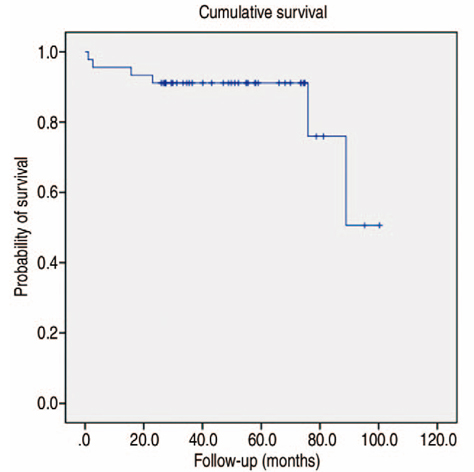Hip Pelvis.
2015 Sep;27(3):135-140. 10.5371/hp.2015.27.3.135.
Mid-term Results of Revision Total Hip Arthroplasty Using Modular Cementless Femoral Stems
- Affiliations
-
- 1Department of Orthopedic Surgery, Keimyung University School of Medicine, Daegu, Korea. oslee@dsmc.or.kr
- KMID: 2069142
- DOI: http://doi.org/10.5371/hp.2015.27.3.135
Abstract
- PURPOSE
The purpose of this study was to evaluate the clinical and radiological results of revision total hip arthroplasty using modular distal fixation stems for proximal femoral deficiency.
MATERIALS AND METHODS
Forty-five patients (47 hips) were analyzed more than 24 months after revision total hip arthroplasty that used modular distal fixation stems and was performed between 2006 and 2012. There were proximal femoral defects in all cases. Preoperative femoral defect classification revealed Paprosky type II in 31 cases, type IIIA in 7, and type IIIB in 9. The mean duration of follow-up was 53.4 (25-100) months. We evaluated the Harris hip score (HHS), walking ability according to Koval as clinical parameters, stem stability, and stem position change as radiographic parameters. Kaplan-Meier survival analysis was performed.
RESULTS
The average HHS improved form 39.5 points to 91.3 points and walking ability also improved in most cases; all patients had stable fixation of the femoral stem. Postoperative complications included 5 cases of infection and 2 cases of dislocation. The survival rate with the end point of re-revision surgery due to infection or dislocation was 86% after 8-year follow-up.
CONCLUSION
Cementless revision total hip arthroplasty using modular femoral stems is useful because the stems can be stably fixed on the diaphyseal portion of the femur, which has relatively good bone quality at mid-term follow-up.
Keyword
MeSH Terms
Figure
Reference
-
1. Sporer SM, Paprosky WG. Revision total hip arthroplasty: the limits of fully coated stems. Clin Orthop Relat Res. 2003; (417):203–209.2. Spitzer AI. The S-ROM cementless femoral stem: history and literature review. Orthopedics. 2005; 28:9 Suppl. s1117–s1124.
Article3. Buly R. The S-ROM stem: versatility of stem/sleeve combinations and head options. Orthopedics. 2005; 28:9 Suppl. s1025–s1032.
Article4. Cameron HU. The two- to six-year results with a proximally modular noncemented total hip replacement used in hip revisions. Clin Orthop Relat Res. 1994; (298):47–53.5. Weeden SH, Paprosky WG. Minimal 11-year follow-up of extensively porous-coated stems in femoral revision total hip arthroplasty. J Arthroplasty. 2002; 17:4 Suppl 1. 134–137.
Article6. Harris WH. Traumatic arthritis of the hip after dislocation and acetabular fractures: treatment by mold arthroplasty. An end-result study using a new method of result evaluation. J Bone Joint Surg Am. 1969; 51:737–755.
Article7. Koval KJ, Skovron ML, Aharonoff GB, Meadows SE, Zuckerman JD. Ambulatory ability after hip fracture. A prospective study in geriatric patients. Clin Orthop Relat Res. 1995; (310):150–159.8. Engh CA, Massin P, Suthers KE. Roentgenographic assessment of the biologic fixation of porous-surfaced femoral components. Clin Orthop Relat Res. 1990; (257):107–128.
Article9. Kaplan EL, Meier P. Nonparametric estimation from incomplete observations. J Am Stat Assoc. 1958; 53:457–481.
Article10. Amenabar T, Rahman WA, Hetaimish BM, Kuzyk PR, Safir OA, Gross AE. Promising mid-term results with a cup-cage construct for large acetabular defects and pelvic discontinuity. Clin Orthop Relat Res. 2015; [Epub ahead of print].
Article11. Mulroy WF, Harris WH. Revision total hip arthroplasty with use of so-called second-generation cementing techniques for aseptic loosening of the femoral component A fifteen-year-average follow-up study. J Bone Joint Surg Am. 1996; 78:325–330.
Article12. Pellicci PM, Wilson PD Jr, Sledge CB, et al. Long-term results of revision total hip replacement A follow-up report. J Bone Joint Surg Am. 1985; 67:513–516.
Article13. Elting JJ, Mikhail WE, Zicat BA, Hubbell JC, Lane LE, House B. Preliminary report of impaction grafting for exchange femoral arthroplasty. Clin Orthop Relat Res. 1995; (319):159–167.
Article14. Fowler JL, Gie GA, Lee AJ, Ling RS. Experience with the Exeter total hip replacement since 1970. Orthop Clin North Am. 1988; 19:477–489.15. Gie GA, Linder L, Ling RS, Simon JP, Slooff TJ, Timperley AJ. Impacted cancellous allografts and cement for revision total hip arthroplasty. J Bone Joint Surg Br. 1993; 75:14–21.
Article16. Krishnamurthy AB, MacDonald SJ, Paprosky WG. 5- to 13-year follow-up study on cementless femoral components in revision surgery. J Arthroplasty. 1997; 12:839–847.
Article17. Moreland JR, Moreno MA. Cementless femoral revision arthroplasty of the hip: minimum 5 years followup. Clin Orthop Relat Res. 2001; (393):194–201.18. Cameron HU. The long-term success of modular proximal fixation stems in revision total hip arthroplasty. J Arthroplasty. 2002; 17:4 Suppl 1. 138–141.
Article19. Chandler HP, Ayres DK, Tan RC, Anderson LC, Varma AK. Revision total hip replacement using the S-ROM femoral component. Clin Orthop Relat Res. 1995; (319):130–140.
Article20. Jones RE. Modular revision stems in total hip arthroplasty. Clin Orthop Relat Res. 2004; (420):142–147.
Article21. Kwong LM, Miller AJ, Lubinus P. A modular distal fixation option for proximal bone loss in revision total hip arthroplasty: a 2- to 6-year follow-up study. J Arthroplasty. 2003; 18:3 Suppl 1. 94–97.
Article22. Wirtz DC, Heller KD, Holzwarth U, et al. A modular femoral implant for uncemented stem revision in THR. Int Orthop. 2000; 24:134–138.
Article23. Hunter GA, Welsh RP, Cameron HU, Bailey WH. The results of revision of total hip arthroplasty. J Bone Joint Surg Br. 1979; 61-B:419–421.
Article24. Gustilo RB, Pasternak HS. Revision total hip arthroplasty with titanium ingrowth prosthesis and bone grafting for failed cemented femoral component loosening. Clin Orthop Relat Res. 1988; (235):111–119.
Article25. Kershaw CJ, Atkins RM, Dodd CA, Bulstrode CJ. Revision total hip arthroplasty for aseptic failure A review of 276 cases. J Bone Joint Surg Br. 1991; 73:564–568.
Article26. Berry DJ. Femoral revision: distal fixation with fluted, tapered grit-blasted stems. J Arthroplasty. 2002; 17:4 Suppl 1. 142–146.
Article27. Chandler H, Clark J, Murphy S, et al. Reconstruction of major segmental loss of the proximal femur in revision total hip arthroplasty. Clin Orthop Relat Res. 1994; (298):67–74.
Article28. Amanatullah DF, Howard JL, Siman H, Trousdale RT, Mabry TM, Berry DJ. Revision total hip arthroplasty in patients with extensive proximal femoral bone loss using a fluted tapered modular femoral component. Bone Joint J. 2015; 97:312–317.
Article29. Schuh A, Werber S, Holzwarth U, Zeiler G. Cementless modular hip revision arthroplasty using the MRP Titan Revision Stem: outcome of 79 hips after an average of 4 years follow-up. Arch Orthop Trauma Surg. 2004; 124:306–309.
Article30. Hoberg M, Konrads C, Engelien J, et al. Outcome of a modular tapered uncemented titanium femoral stem in revision hip arthroplasty. Int Orthop. 2015; 39:1709–1713.
Article31. Wirtz DC, Gravius S, Ascherl R, et al. Uncemented femoral revision arthroplasty using a modular tapered, fluted titanium stem: 5- to 16-year results of 163 cases. Acta Orthop. 2014; 85:562–569.
Article32. Brown NM, Tetreault M, Cipriano CA, Della Valle CJ, Paprosky W, Sporer S. Modular tapered implants for severe femoral bone loss in THA: reliable osseointegration but frequent complications. Clin Orthop Relat Res. 2015; 473:555–560.
Article33. Barrack RL. Orthopaedic crossfire--Stem modularity is unnecessary in revision total hip arthroplasty: in the affirmative. J Arthroplasty. 2003; 18:3 Suppl 1. 98–100.
Article34. Bobyn JD, Tanzer M, Krygier JJ, Dujovne AR, Brooks CE. Concerns with modularity in total hip arthroplasty. Clin Orthop Relat Res. 1994; (298):27–36.
Article
- Full Text Links
- Actions
-
Cited
- CITED
-
- Close
- Share
- Similar articles
-
- Revision Hip Arthroplasty with a Cementless Femoral Stem
- Risk Factors Related to Modular Femoral Stem Failures in Revision Hip Arthroplasty
- Modular Stems: Advantages and Current Role in Primary Total Hip Arthroplasty
- Usefulness of a Modular Hip System for Combined Anteversion in Cementless Total Hip Arthroplasty
- Femoral Revisional Arthroplasty using Proximal Modular Femoral Stem: Short Term Follow Up





